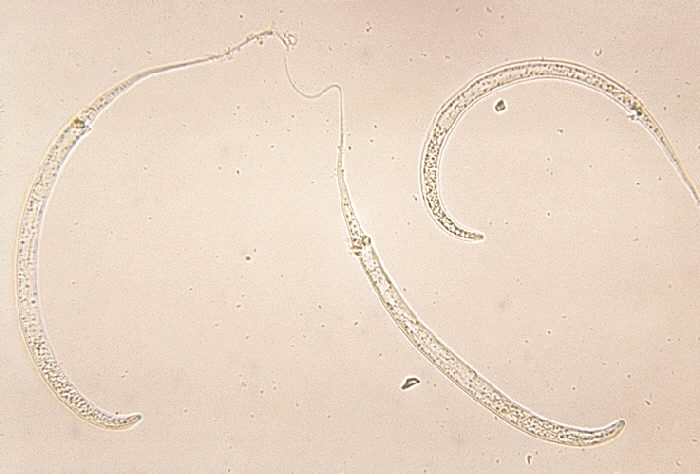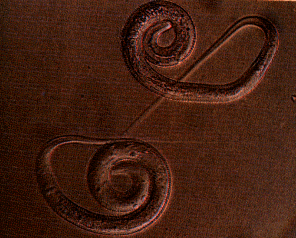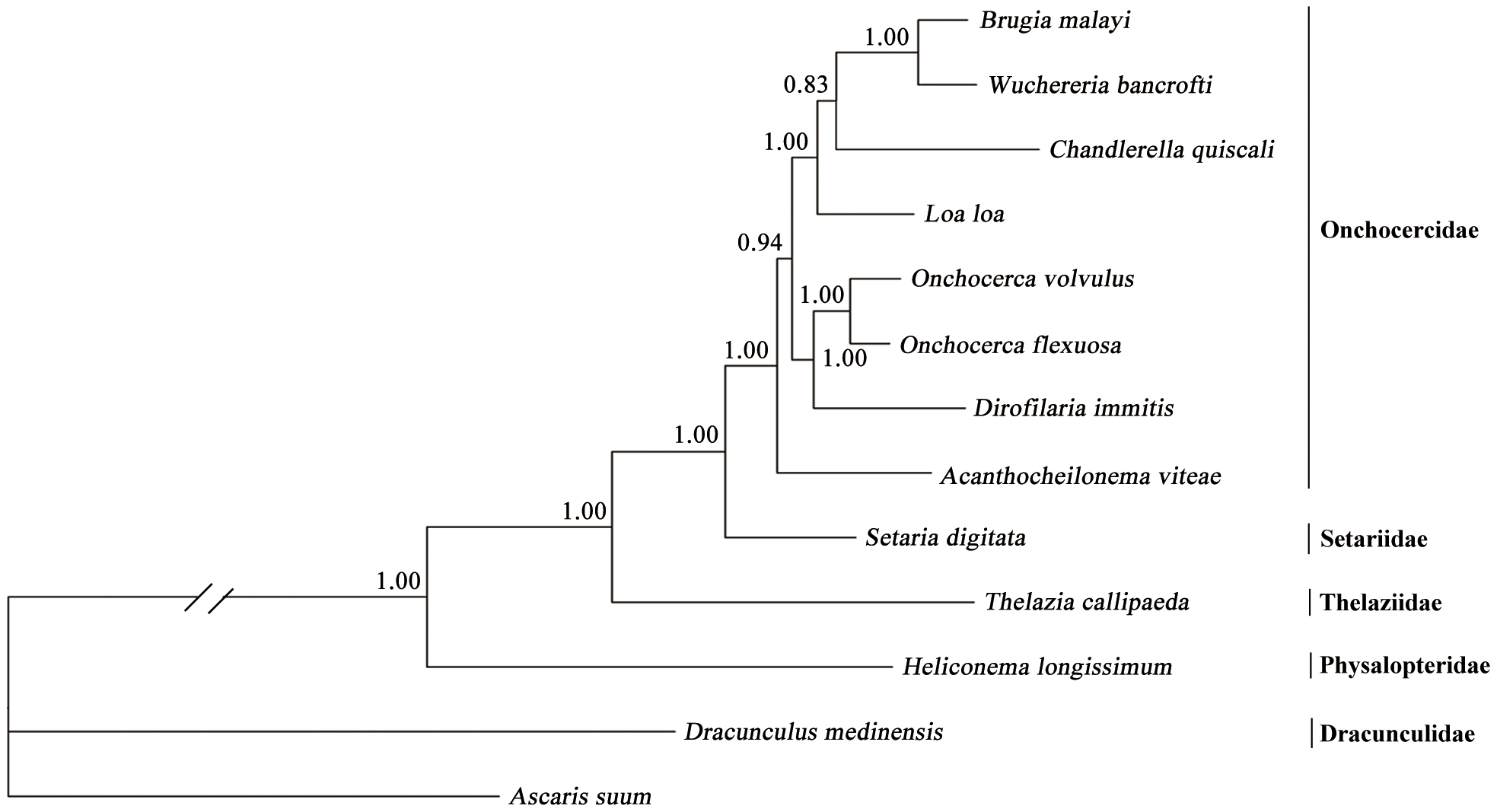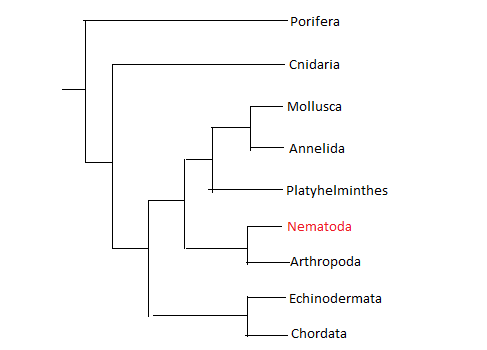Classification
Scientific Name: Dracunculus
medinensis
Common Name:
Guinea Worm
Named by
Linnaeus in 1758
Domain: Eukarya
Kingdom: Animalia
Phylum: Nematoda
Class: Secernentea
Order: Camallanida
Family: Dracunculidae
Genus: Dracunculus
Species:
medinensisDomain: Eukarya:: Dracunculus medinensis is an organism in
which each cell contains a nucleus and membrane-bound organelles.
Kingdom: Animalia:: D. medinensis is a multicelluar organism
that is heterotrophic, meaning that its energy is derived from the
consumption of other organisms. Due to D. medinensis
being a parasite, it receives nutrition from its host. To learn more
about parasitic animals please visit
Taenia saginata.
Phylum: Nematoda:: Nematodes, including the Guinea Worm, contain a
cuticle around their body for protection. This is their
synapamorphy, or derived characteristic, shared by all organisms
within the phylum. In addition, these organisms move with the use of
a hydrostaticskeleton. These skeletons use the force and pressure of
water to move in aquatic, soil, and other environments. The Guinea
Worm is a parasite, and therefore uses its hydrostaticskeleton to move
throughout mammalian and reptilian hosts. Nematodes can also be
classified by their bodies containing: radial symmetry and true
tissues composed of specialized cells working together for different
functions. These tissues can be associated with three different body
sections of a triploblast: endoderm, mesoderm, and exoderm. The
differentiation of these body sections begins with the formation of
the mouth and leads to the formation of the anus. This is referred
to as a protostome. Nematodes are also ecdysozoa meaning that at
some point within their life cycle, they will molt. D.
medinensis molt twice within their lifetime (Yusuf 2011). More
information on the life cycle of D. medinensis can be found
on the reproduction
page. For more information on Nematoda please read through the
classification of the
Dog Whipworm and
Heartworm.
Class: Secernentea:: The guinea worm is from class Secernentea
(Yusuf 2011). Secernentea are terrestrial parasites that contain a
speared head to puncture hosts (animals.jrank.org 2014). In the case
of D. medinensis, their hosts range from mammals to
reptiles as discussed in further detail in
habitat and geography. For more information on parasitic
Secernentea please read about the classification page of
Wuchereria bancrofti.
Order: Camallanida:: Dracunulus medinensis is from the
order Camallanida (Yusuf 2011). Camallanida are parasites of
copepods, or cylops (plpmenweb.ucdavis.edu 2001). D. medinensis
infects cyclops in pond water where it is then drank by the host and
travels through the digestive system (Cairncross, Tayeh, and Korkor 2012).
Family: Dracunculidae:: D. medinensis is classified into
the family Dracunculidae (Yusuf 2011).
Genus: Dracunculus:: The genus of the guinea worm is
Dracunculus (Yusuf 2011). This genus
contains mammalian and reptilian parasites. The Guinea Worm
has been found in both mammals and reptiles (Wijová, Moravec, Horák,
Modrý and Lukeš 2005). Although, recent genetic analysis suggests
that the Guinea Worm infects only humans (Yusuf 2011).
Species: medinensis:: The specific epithet of the guinea
worm is medinensis. This species infects humans in
the African region, but are not fatal (Yusuf 2011).
This phylogenetic tree shows Dracunculus medinensis as an outgroup in the comparison of the evolutionary relatedness of the family Thelaziidae. This tree was created using mitochondrial genetic material. All of the listed species are from the phylum Nematoda (Liu G-H, Gasser RB, Otranto D, Xu M-J, et al. 2013). The fact that D. medinensis is an outgroup refers to the idea that it is not immediatley related to Thelazia callipaeda, but was used to help establish the evolutionary relatedness of the species to be placed within a phylogeny. For more information on the use of D. medinensis aiding in the classification of Thelazia callipeada please read this article: "Mitochondrial Genome of the Eyeworm, Thelazia callipaeda (Nematoda: Spirurida), as the First Representative fromt the Family Thelaziidae."
This phylogenetic tree is based off of the classification of Phyla within the family Animalia. Dracunculus medinensis is in the phyllum Nematoda. As mentioned above, nematodes are round worms. Within this phylogeny, Nemaotoda is most closesly related to Arthropoda which are known for their jointed limbs. An example of an Arthropoda can be found here Gastrophilus intestinalis.
For more information on the classification of Dracunculus medinensis please read: "End of the horror worm: Dracunculus medinensis."
Next Page: Habitat





